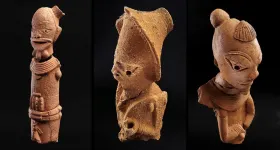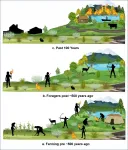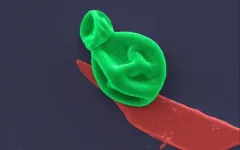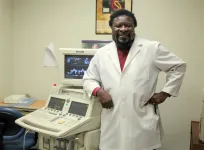Lab study solves textbook problem: How cells know their size
The answer to a basic science question could unlock the key to complex medical challenges
2021-04-14
(Press-News.org) HANOVER, N.H. - April 14, 2021 - Scientists have searched for years to understand how cells measure their size. Cell size is critical. It's what regulates cell division in a growing organism. When the microscopic structures double in size, they divide. One cell turns into two. Two cells turn into four. The process repeats until an organism has enough cells. And then it stops. Or at least it is supposed to.
The complete chain of events that causes cell division to stop at the right time is what has confounded scientists. Beyond being a textbook problem, the question relates to serious medical challenges: Cells that stop dividing too soon can cause defects in growing organisms. Uncontrolled cell growth can lead to cancers or other disorders.
A study from Dartmouth, published in Current Biology, provides a new answer to the question by tackling the problem in reverse: The research focused on large cells that reduce their size through division until enough cells are formed to move to other stages of development.
"The early embryo is an ideal place to study cell size control," said Amanda Amodeo, an assistant professor of biology at Dartmouth and the lead researcher. "The cells we work with are eggs that are visible to the eye. They don't need to grow before dividing, so it allows us to look at connections that are obscured in adult cells."
According to the study, a set amount of the protein histone H3 is loaded into an embryo before fertilization and is used up as the embryo divides into more cells. As histones are consumed to accommodate the growing number of nuclei, they release the enzyme Chk1 to bind with another protein, CDC25, to stop the multiplication of cells.
The research is technical, but the mechanism is relatively straightforward: With histone H3 out of the way in a growing cell, the stop enzyme Chk1 finds and disables the protein that triggers cell cycle progression, CDC25.
"The key to our research result was coming up with the possibility that unusually large amounts of histone H3 may feed into the stop enzyme," said Yuki Shindo a postdoctoral research fellow at Dartmouth and first author of the paper. "Once we noticed that, we were able to test this idea in our living test tube, fruit fly eggs."
The new research builds on earlier studies which found that a biological constant exists between the size of a genome and the size of a cell. Researchers knew that once a balance point was achieved, cells would stop duplicating, but didn't understand how cells could determine the ratio.
To find the answer to the long-running question, the research team studied fruit fly eggs. Because of their large size compared to other cells, the team was able to get a different perspective on the cell cycle.
"We've had all of the pieces for years but couldn't quite get them to fit together," said Amodeo. "Once we recognized that H3 interacts directly with both DNA and Chk1, the work went very fast. Everything worked the first time, which is a good sign that the hypothesis is right."
Since the same molecules that control cell division--histone H3, CDC25 and Chk1--are all identified in cancer and other ailments, the finding can help researchers that are seeking answers to questions related to development and disease.
"We were originally curious about a basic biological question on how cells in a growing egg make a decision to stop at the correct timing," said Shindo. "We are now excited that our findings may also have an important implication for a broader context such as disease."
INFORMATION:
Research conducted for this study was performed at and supported by the Lewis-Sigler Institute at Princeton University as well as by grants from the Japan Society for the Promotion of Science, the Uehara Memorial Foundation, and the Japanese Biochemical Society.
About Dartmouth
Founded in 1769, Dartmouth is a member of the Ivy League and offers the world's premier liberal arts education, combining its deep commitment to outstanding undergraduate and graduate teaching with distinguished research and scholarship in the arts and sciences and its leading professional schools: the Geisel School of Medicine, the Guarini School of Graduate and Advanced Studies, Thayer School of Engineering and Tuck School of Business.
[Attachments] See images for this press release:
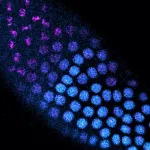
ELSE PRESS RELEASES FROM THIS DATE:
2021-04-14
LOS ANGELES (April 13, 2021) -- The Lundquist Institute (TLI) Investigator Dong W. Chang, MD, and his colleagues' study on critically ill patients and ICU treatments was published in JAMA Internal Medicine. The study - "Evaluation of Time-Limited Trials Among Critically Ill Patients with Advanced Medical Illnesses and Reduction of Nonbeneficial ICU Treatments" - found that training physicians to communicate with family members of critically ill patients using a structured approach, which promotes shared decision-making, improved the quality of family meetings. This intervention was associated with reductions in invasive ICU treatments that prolonged suffering without benefit for patients and their families.
"Invasive ICU treatments are frequently delivered to patients ...
2021-04-14
In April 2019, scientists released the first image of a black hole in galaxy M87 using the Event Horizon Telescope (EHT). However, that remarkable achievement was just the beginning of the science story to be told.
Data from 19 observatories released today promise to give unparalleled insight into this black hole and the system it powers, and to improve tests of Einstein's General Theory of Relativity.
"We knew that the first direct image of a black hole would be groundbreaking," says Kazuhiro Hada of the National Astronomical Observatory of Japan, a co-author of a new study published in The Astrophysical Journal Letters that ...
2021-04-14
If global warming continues unchecked, summer monsoon rainfall in India will become stronger and more erratic. This is the central finding of an analysis by a team of German researchers that compared more than 30 state-of-the-art climate models from all around the world. The study predicts more extremely wet years in the future - with potentially grave consequences for more than one billion people's well-being, economy, food systems and agriculture.
"We have found robust evidence for an exponential dependence: For every degree Celsius of warming, monsoon rainfalls will likely increase by about 5%," says lead author Anja Katzenberger from the Potsdam-Institute ...
2021-04-14
A team of scientists, led by the University of Bristol, with colleagues from Goethe University, Frankfurt, has found the first evidence for ancient honey hunting, locked inside pottery fragments from prehistoric West Africa, dating back some 3,500 years ago.
Honeybees are an iconic species, being the world's most important pollinator of food crops. Honeybee hive products, including beeswax, honey and pollen, used both for food and medicinal purposes, support livelihoods and provide sources of income for local communities across much of Africa, through both beekeeping ...
2021-04-14
A potential treatment for dementia and epilepsy could look to reduce the amounts of a toxic gas in the brain has been revealed in a new study using rat brain cells.
The research published in Scientific Reports today [Wednesday 14 April] shows that treatments to reduce levels of hydrogen sulfide (H2S) in the brain may help to ward off damage caused by the gas. By testing rat brain cells, the team of scientists from the University of Reading, University of Leeds and John Hopkins University in the USA found that H2S is involved in blocking a key brain cell gateway ...
2021-04-14
If you were to visit the Great Basin and Colorado Plateau a thousand years ago, you'd find conditions remarkably familiar to the present. The climate was warm, but drier than today. There were large populations of Indigenous people known as the Fremont, a who hunted and grew crops in the area. With similar climate and moderate human activity, you might expect to see the types of wildfires that are now common to the American West: infrequent, gigantic and devastating. But you'd be wrong.
In a new study led by the University of Utah, researchers found that ...
2021-04-14
CLEVELAND, Ohio (April 14, 2021)--Despite all the advances in medicine, some basic questions remain. For example, people cannot be told with any certainty how long they'll live. Nor can it be predicted exactly when a woman's childbearing years will end. However, a new study offers insights into factors that might predict a woman's age at natural menopause. Study results are published online today in Menopause, the journal of The North American Menopause Society (NAMS).
Factors that affect age at natural menopause are one of the most frequently studied topics in menopause-related research in recent decades, and with good reason. Knowing when a woman will enter menopause could be ...
2021-04-14
Researchers have developed a new superbug-destroying coating that could be used on wound dressings and implants to prevent and treat potentially deadly bacterial and fungal infections.
The material is one of the thinnest antimicrobial coatings developed to date and is effective against a broad range of drug-resistant bacteria and fungal cells, while leaving human cells unharmed.
Antibiotic resistance is a major global health threat, causing at least 700,000 deaths a year. Without the development of new antibacterial therapies, the death toll could rise to 10 million people a year by 2050, equating to $US100 trillion in health care costs.
While the health burden of fungal infections is less recognised, globally they kill about ...
2021-04-14
Researchers from University of Hawaii and Cornell University published a new paper in the Journal of Marketing that explores the challenges and opportunities with nonprofit fundraising to provide organizations with strategies they can use to increase sustainable giving and profitability.
The study, forthcoming in the Journal of Marketing, is titled "Managing Members, Donors, and Member-Donors for Effective Non-profit Fundraising" and is authored by Sungjin Kim, Sachin Gupta, and Clarence Lee.
Individual philanthropy is the primary funding source for many nonprofit organizations. A major challenge facing such organizations ...
2021-04-14
While a slow resting heart rate is generally considered a good thing, investigators have some of the first evidence that if that rate decreases rapidly as children move into young adulthood, it's an indicator that cardiovascular disease may be in their future.
Medical College of Georgia investigators report a significant association between a faster decrease in resting heart rate from childhood to adulthood and a larger left ventricle, the heart's major pumping chamber, over a 21-year period in hundreds of individuals who were healthy at the start.
The faster decrease in heart rate also was associated with a higher level of pressure inside the blood vessels of the body, which ...
LAST 30 PRESS RELEASES:
[Press-News.org] Lab study solves textbook problem: How cells know their size
The answer to a basic science question could unlock the key to complex medical challenges


